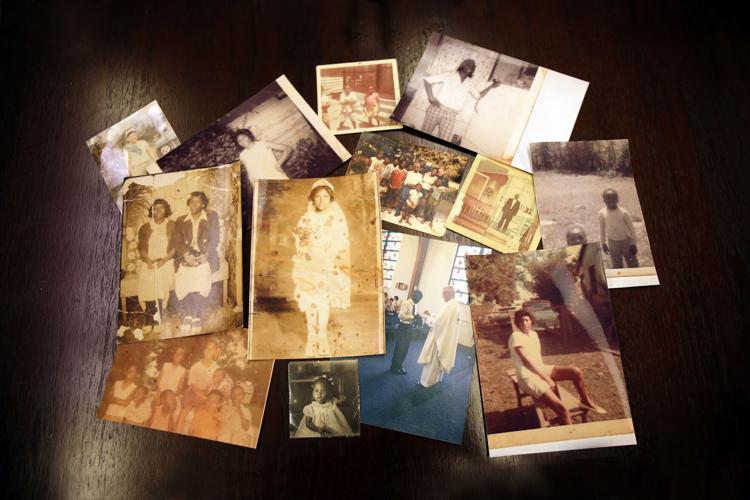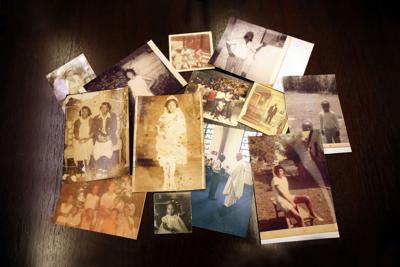Three million dollars.
That's the modern equivalent of the price paid for 272 slaves of African descent in 1838, all sold to Louisiana plantations by Jesuit priests who baptized them into the Catholic faith.
The priests considered these people their property, to be bought and sold to fund the mounting debt of a Jesuit-founded college that would become Georgetown University.

A photo of an original manifest for the 272 slaves sold by Jesuit priests to plantations in Louisiana to fund Georgetown University.
The great irony
"The irony is we're all devout, confirmed Roman Catholics," said Ernest Emerson Jones. "And with the Jesuits being a large sect of the Catholic church and the history of it, it all falls into place."
Jones is one of 12 descendants of those 272 slaves interviewed for the Southern University's Georgetown University 272 History Memory Project, or GU272. Southern initiated the oral histories in August 2021 after receiving a $25,000 grant from the Social Science Research Council awarded specifically for GU272.
Southern's project specifically seeks out descendants who have ties to the university, while a bigger Georgetown Memory Project, founded by Georgetown alumnus Richard Cellini, searches for and documents the family trees of all 272 slaves.

A rendering by Casimir Bohn shows Georgetown College as it appeared between 1789 and 1815. The college later would be renamed Georgetown University.
Connecting the dots
Cellini, an attorney in Boston and CEO of a tech startup, was the first to contact Jones about the project and history. Jones previously didn't know the story of how the sale of 272 men, women and children was used as a bailout for what was then Georgetown College in Washington, D.C.
John Sebastian Jones, Ernest Emerson Jones' great-grandfather, was a descendant of Henry Plowden, born 1787, and Elizabeth Betsy Hill, born 1792, both in Maryland. Hill died in Louisiana between 1839 and 1851. Plowden's date and place of death are unknown. Both Plowden and Hill were part of the 272 slaves sold to pay off Georgetown's debts.
John Sebastian Jones was a founder of and the first dean of students for Southern University in Baton Rouge.

Ernest Emerson Jones, right, and Karran Royal stand with a photo of Jones' great-great-grandfather, one of the original founders of Southern University in Baton Rouge. Jones and Royal are both part of Southern University's GU272 project.
Southern Archives gather oral histories
Ernest Emerson Jones is among 12 featured through oral history interview videos, transcripts and accompanying research material of Southern-connected GU272 descendants. There are at least 8,000 other descendants, who live mostly in Louisiana and Maryland.
"We're always looking for more descendants with ties to Southern University," said Angela Proctor, head university archivist and digital librarian.

Angela Proctor, head university archivist and digital librarian, stands in the Troy Allen Reading Room at Southern's John B. Cade Library, where most of the GU272 interviews took place.
The interviews took place between October 2021 and July 2022. Some were conducted virtually, but most took place in the archives department's Troy Allen Reading Room at Southern's John B. Cade Library.
Those interviews, along with all other research connected to the project, is available online by visiting 7008.sydneyplus.com/final/Portal/SouthernUniversity.aspx.
Traced to plantations in New Iberia and Maringouin
"Most of the 272 enslaved people were sold to plantations around New Iberia and Maringouin," Proctor said. "And though they'll keep the name of the project as GU272, we now know that the number of individuals sold during this sale has increased to at least 314. Tradition claimed that all of these people perished on the way to Louisiana, but they survived. Many of them lived through the Civil War, then lived long enough to see emancipation."

A photo of the slave cabins at Laurel Valley in Thibodaux is part of the GU272 Memory Project. Jesuit priests in Maryland sold 272 slaves to Louisiana plantations in 1838 to fund Georgetown University.
Specifically, the slaves were sent to West Oak Plantation in Iberville Parish on the Bayou Maringouin, which was owned by Jesse Batey, and a nearby plantation in Maringouin, owned by Henry Johnson, as was Ascension Plantation, later known as Chatham Plantation, in Ascension Parish near Donaldsonville.
Around ninety Georgetown slaves were initially transplanted to Maringouin. Many descendants of the GU272 still live in Maringouin and adjacent communities.
8,000 descendants and counting
More than 8,000 of the descendants have been located using genealogical research. While many are now living successful lives, the story of their ancestors begins with Georgetown's founding in 1789 by John Carroll.

A photo of a record for a man simply known as Isaac, who was sold to Louisiana plantations. The sale funded Georgetown University. This photo is part of the ongoing GU272 Memory Project.
Carroll was the first Catholic bishop and archbishop in the United States. He also was a member of the Society of Jesus, or the Jesuits. His specific order was the Jesuits of Maryland, who owned and ran the college.
"The Jesuits also owned and operated tobacco plantations throughout Maryland that ran on enslaved labor," Proctor said. "The profits made from these plantations were used to run the university."
Photos: The GU272 Memory Project at Southern University and Georgetown University
Then came 1838.
Debts from the college's construction and maintenance began mounting and a quick influx of cash was needed to keep the school afloat. On June 19, 1838, the Jesuits from Georgetown signed a contract with Louisiana sugar plantation owners Jesse Batey and Henry Johnson to sell 272 of their enslaved men, women and children for a total $115,000 to plantations in Louisiana, the equivalent of $3.3 million in today's dollars.
Johnson was a congressman from Louisiana who had previously served as governor and U.S. senator.
"Many of these families were separated and sent to other plantations," Proctor said. "But they didn't perish. They married and raised children."

Photographer Claire Vail shot photos of slave cabins in Maringouin, Whitney Plantation, Houma and other locations where the 272 slaves were sold by Jesuit Priests in 1838 to fund Georgetown University. This is the interior of one of those cabins.
Passing down their faith
Proctor added that the slaves also were baptized in the Catholic faith by either Father Thomas Mulledy, president of Georgetown from 1829 to 1837, or his successor, Father William McSherry.
As is the case of Jones' family, many of the 272 passed down their faith to the generations that followed.
Jones, 52, splits his time between Orlando, Florida, and Austin, Texas. He is general manager and head of sales for Amazon Web Services for North America. He's also the only non-Southern graduate among the 12 the university interviewed for their part of the project, but his school ties are strong.

Photographer Claire Vail shot photos of slave cabins in Maringouin, Whitney Plantation, Houma and other locations where the 272 slaves were sold by Jesuit Priests in 1838 to fund Georgetown University.
Southern connections
First, there's his aforementioned great-grandfather, who was one of the founders. Then there's his great-great-grandfather, who had a different role associated with the school.
"Richard Jones was a founder of Leland College, which was a feeder school to Southern," Jones said. "Then, John Sebastian Jones' son, Ralph Waldo Emerson Jones, served 41 years as president of Grambling State University. That was my grandfather, and Grambling's name was changed from college to university while he was there. He also hired Eddie Robinson to coach the football team in 1941."
Though he has a rich lineage in Louisiana's historically black colleges and universities, Jones chose a different route, first earning a bachelor's degree in mechanical engineering from the University of Delaware in Newark. He followed that up with a master's degree in business administration from the University of North Carolina at Chapel Hill.

This photo titled "Frank Campbell" was submitted by descendants to the GU272 Memory Project. The photo was taken on plantation grounds where some of the 272 slaves sold by Jesuit priests in 1838 lived.
Coincidentally, when Jones' son was applying to attend Georgetown University in 2017, Cellini and the GU272 organization contacted him about the project.
"Mr. Cellini and his organization just reached out serendipitously, ironically during my son's application process to Georgetown, and we sent in DNA testing," he said.
The timing of his son's application process was coincidental. Unfortunately, his son's application was turned down, but the DNA test turned up a match: Jones is a direct descendant of the 272.
"That was awesome, because it connected some dots for us," he said. "By the way, I grew up in Maryland, 40 minutes from Georgetown's campus."
Jones is quick to point out that he also has direct ties to Southern on his mom's side of the family.
"Both of her parents were Southern graduates, and her mother, Zola, was Miss Southern," Jones said. "So, all four of my grandparents were graduates of Southern."

A photo of a second manifest for the 272 slaves sold by Jesuit priests to plantations in Louisiana to fund Georgetown University.
Jones' story is just one among many in this project, one that not only traces descendants of the 272 but highlights their successes and contributions. His is one example of thousands of how those whose lives were sold to save Georgetown University will not be forgotten.












